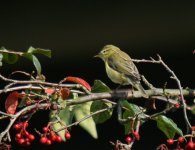And finally for Adam here is a blast from the past that I put together 6th January 2008. One for your scrap book Adam:-O
The Leaves Have Fallen-A Staffordshire Moorlands Woodland Journey:
The leaves have fallen, the trees not dead but without clothing. It is deep winter here, the afternoon cold and frost is on the ground in this 9000 year old hilly wooded kingdom of the Staffordshire Moorlands.
I inhale the clean cold air and listen to the peace, quiet, and tranquillity of this place. I am at home here in this wooded world frequented across the seasons by birds, mammals, insects, butterflies, moths, and bats.
I hear the quiet chatter of birds and the sun is low in the sky as I make my way on foot moving quietly into Coombes Valley. No other humans are present just me, no noise, no bustle, no distractions, no mobile phones.
There is movement ahead of me as a pair of Bullfinches feed on the ground close to a hedge. Chaffinches are close by and a single Blackbird is perched on a small tree to my left. A Robin appears moving between stonewall, hedge and tree keeping an eye on my progress. Perhaps I am an intruder in their world, not to be trusted. I am being watched by many eyes. I hear the occasional alarm call from above and in the undergrowth.
In this avenue of hedge, trees and stone walls I see Blue Tits and Great Tits manoeuvring around branches and in flight across the cattle grazed pasture to my left and above the hay meadow a little further along on my woodland journey.
The birds are busy feeding to survive another night in this upland habitat, survivors they are and all look strong and healthy. A solitary Greenfinch appears and quickly departs. Coal Tits mingle with the Blue Tits and Great Tits. Feeding, feeding, feeding is the name of the game that these birds play.
Another lone birder approaches and there is quiet acknowledgment of one another as we pass by both savouring the moment.
Descending into the valley I hear the distant babbling of Coombes brook where Signal Crayfish lurk, Dippers and Grey Wagtails live and breed. There are none to be seen today though and no signs that they have been around. Perhaps the Grey Wagtail has moved to the lower reaches of the Churnet Valley. I cannot comment for the Dipper I say to myself.
I take a higher path that works its way through woodland on the upper slopes to the right of me leaving the central path and acquire views through leafless trees across the Coombe and gradually descend again to the pond at the base of this magical landscape. All is quiet, no sign of birdlife and I wait until spring for the return of migrant birds such as Pied Flycatchers and Redstarts singing in their territories.
In the spring bluebells and wood anemones will appear in the woodland, perhaps Grey Wagtails will return and sightings of dipper on the brook will once again please my birding eyes. There will be early butterflies, Holly Blues and Brimstones, something to look forward to which I reflect on briefly.
The pond is frozen, with no possibility of Kingfisher today. It is completely silent other than the flowing Coombes Brook to my left and below the pond.
I make my way across Clough Meadow and a thin veil of cloud is arriving from the west spelling rain for the evening. It is time to make a gradual ascent of the valley and a return to Blackbirds, Blue Tits and Great Tits, Robins, Coal Tits, House sparrows, a solitary Magpie across the hay meadow, wood pigeons and crows in flight and finally a Kestrel perched and sometimes hovering looking for its next meal.
I watched the Kestrel, a medium sized falcon at close quarters, perched with only its head moving, looking and searching and when taking to the air its flight agile and quick.
Reaching the top of the Coombe and the end of my journey on foot I looked beyond the valley to the sun now very low in the sky, falling behind cloud and a yellow and orange glow to warm my thoughts.
If only I could immerse myself full time in nature I say to myself.
The repeated atmospheric call of a Buzzard reaches me from afar to help me on my way.
Dean












